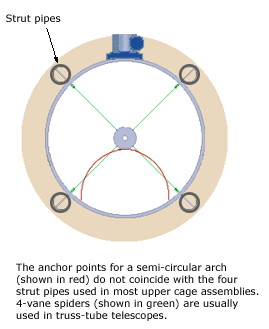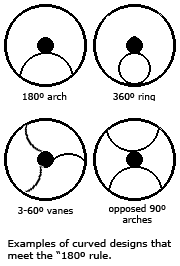Frequently Asked Questions (FAQ)
Curved secondary mounts
(last updated July 19, 2022)
Will a curved secondary mount improve the quality of the image?
What are the disadvantages to using a curved secondary mount?
Does the 180º arch spread the diffraction symmetrically around bright objects in the field?
Why aren't curved mounts available for larger telescopes?
Why aren't Protostar curved mounts available for (most) truss-style telescopes?
What does "total diffraction" mean?
Is the curved mount as stable as the straight-vane mounts?
Why is the arch made of stainless steel (and not aluminum, or carbon fiber)?
Why does Protostar use the 180º arch design?
Is the anti-dew heater option available on curved secondary mounts?
Is the built-in offset option available on curved secondary mounts?
How difficult is it to install a Protostar curved mount?
Will a curved secondary mount improve the quality of the image?
The simplest answer is "no", but it is slightly more complicated. Most people think of image quality as "sharpness", and evaluate this based on visually splitting close double stars or trying to glimpse very small surface details on a solar system object. By these measures, a curved secondary support will have essentially no advantage — at least compared to a well-designed straight-vane mounting.
 A curved mount is specifically designed to eliminate diffraction spikes emanating from bright objects in the field of view (see image). These spikes are created when anything with a straight edge obstructs the aperture (a straight-vane spider being the most obvious example). When a curved edge with an integrated angle of 180º (or multiples of 180º) obstructs the aperture, the resulting diffraction is spread uniformly around bright objects. At modest to high magnifications, the diffraction is diluted enough to be invisible to your eye.
A curved mount is specifically designed to eliminate diffraction spikes emanating from bright objects in the field of view (see image). These spikes are created when anything with a straight edge obstructs the aperture (a straight-vane spider being the most obvious example). When a curved edge with an integrated angle of 180º (or multiples of 180º) obstructs the aperture, the resulting diffraction is spread uniformly around bright objects. At modest to high magnifications, the diffraction is diluted enough to be invisible to your eye.
Newtonian telescope users have different tolerance levels to diffraction spikes. Many have grown used to them, or observe at high enough powers to where they are unnoticeable. To others, they disturb the otherwise perfect aesthetics of the view.
What are the disadvantages to using a curved secondary mount?
A straight-vane spider has a big mechanical stiffness advantage over any curved design. The tensioned vanes permit the spider to be thin, yet strong. With curved designs, the loss of rigidity must be made up by using thicker or wider vanes. Some types of curved designs with thick vanes will create several times as much total spider diffraction. The linear spikes will be gone, but there will be a wide diffraction glow around objects like bright planets.
The Protostar curved arch largely eliminates this problem with a pre-stressed, tapered, arch design that is highly efficient compared to a simple bent piece of flat stock metal. Thin stainless steel is used to keep the total diffraction (or obstruction ratio, as defined in question 6 below) about the same as our straight-vane mounts. In fact, the total diffraction is usually less than the 4-vane mounts.
Does the 180º arch spread the diffraction symmetrically around bright objects in the field?
Yes, any obstruction with an integrated edge angle of 180º, or a multiple of 180º (360º, 540º, etc.), will diffract light in a uniform pattern. It does not matter that the arch itself is mounted off to one side of the aperture.
Why aren't curved mounts available for larger telescopes?
There is no inherent reason the single-arch design could not be used with any size of telescope (scaled appropriately, of course), but most large Newtonian telescopes are truss-tube types. Our curved mounts will not fit inside the upper cages of most truss-style scopes for the reason stated in the next question.
Why aren't Protostar curved mounts available for (most) truss-style telescopes?
 Any secondary support needs to be anchored to a solid structural component of the telescope. For most truss-style upper cages the only attachment points available are the four struts pipes. Their location (i.e., 90º spacing) does not coincide with where the curved mount needs to attach — at least if you want it to be a 180-degree arch.
Any secondary support needs to be anchored to a solid structural component of the telescope. For most truss-style upper cages the only attachment points available are the four struts pipes. Their location (i.e., 90º spacing) does not coincide with where the curved mount needs to attach — at least if you want it to be a 180-degree arch.
If your upper cage design uses a solid tube section instead, you probably can use our curved mount. If you have any questions, it is best to call us before ordering.
Important note: Never attach the curved mount to the thin plastic liner (i.e., "Kydex") inside many upper cages. It is not strong enough to support the secondary mounting.
What does "total diffraction" mean?
 Total diffraction from the secondary support vanes is a function of the edge-on area of the vanes divided by the area of the mirror. This value is called the obstruction ratio. The appearance and intensity of diffraction artifacts (like spikes) is a function of the obstruction ratio alone, and not the thickness of the vanes by themselves.
Total diffraction from the secondary support vanes is a function of the edge-on area of the vanes divided by the area of the mirror. This value is called the obstruction ratio. The appearance and intensity of diffraction artifacts (like spikes) is a function of the obstruction ratio alone, and not the thickness of the vanes by themselves.
Using geometry, you can calculate the obstruction ratio, and compare the total diffraction produced by different spider designs — even between scopes of different apertures. For the example illustrated, the edge-on area of the vanes is 600 mm² and the area of the primary mirror is 17,688 mm² Thus the obstruction ratio is (600 / 17,688), or 0.034. (When making this calculation, do not include parts of the spider vanes outside of the mirror's diameter, and ignore the secondary mirror.)
A different secondary support with 4 mm thick vanes would have an obstruction ratio of 0.068. It would diffract twice as much light energy (from the spider alone, not including the secondary mirror).
The same method can be used for curved mounts. The value of the obstruction ratio for Protostar curved mounts falls between our 3-vane and 4-vane secondary mounts.
Is the curved mount as stable as the straight-vane mounts?
No, and there is no curved secondary design will match the mechanical strength that tensioned, straight, vanes can provide. However, Protostar curved mounts are more than rigid enough for the task, and are designed to satisfy both static and dynamic stability requirements as defined in the next paragraph.
The minimum static flexure requirement is that collimation should not shift when the scope is slewed from a horizontal to vertical position. Dynamically, the secondary should not resonate excessively after a jolt to the tube. Protostar curved mounts are designed to dampen vibration well within one second.
Why is the arch made of stainless steel (and not aluminum, or carbon fiber)?
Aluminum has a superior strength-to-weight ratio compared to steels, but for a spider a high strength-to-volume ratio is desired. In order to keep the vanes thin, it's required to fit as much strength into as small of a volume as possible. A spider made of aluminum would need to be about 2.5 times as thick as a steel vane to have equivalent rigidity. (The modulus of elasticity of steel is three times aluminum's.)
A similar thing is true for carbon fiber materials, but to a lesser degree. The modulus of common carbon fiber materials is about 24-28 Mpsi, whereas steels are around 30 Mpsi. This means the vane would have to be slightly thicker to have the equivalent rigidity of a steel vane. There is also a problem processing carbon composites that are as thin as our vanes (~ 0.5 mm). This reason alone usually forces a carbon composite vane to be 1.0 to 1.5 mm in thickness.
Why does Protostar use the 180º arch design?
 There are many secondary support configurations that meet the "180-degree rule", and thus, symmetrically spread diffraction. The 180º arch design yields the highest ratio of rigidity (a mechanical design consideration) to obstruction ratio (an optical design consideration). Another way of saying this is that for a given amount of edge-on obstruction, a 180º arch is the most stable of the curved designs. In theory, the 180º single-arch design can be scaled up for any size Newtonian.
There are many secondary support configurations that meet the "180-degree rule", and thus, symmetrically spread diffraction. The 180º arch design yields the highest ratio of rigidity (a mechanical design consideration) to obstruction ratio (an optical design consideration). Another way of saying this is that for a given amount of edge-on obstruction, a 180º arch is the most stable of the curved designs. In theory, the 180º single-arch design can be scaled up for any size Newtonian.
However, other less-obvious factors may steer you towards one design over another. For example, a typical truss-style upper cage does not have anchoring points for our 180º arch at the necessary locations (see question 5). If you wanted to use a curved mount on a truss-style scope, a 4-vane curved mount would work better, even at the expense of more total diffraction. (If the upper cage had only three strut pipes, then a 3-vane curved mount would be the natural choice.)
In short, choosing the right curved mount involves meeting mechanical requirements, as well as the optical considerations.
Is the anti-dew heater option available on curved secondary mounts?
No, the anti-dew heater option is only available on straight-vane secondary mounts.
Is the built-in offset option available on curved secondary mounts?
No, but it is not needed since the mounting brackets permit precise positioning of the secondary within the tube. You can incorporate offset yourself through this adjustment.
How difficult is it to install a Protostar curved mount?
There are a few different steps, but it is similar to installing a straight-vane mounting. Our best recommendation is to read through the installation instructions (980 kB pdf) before ordering.